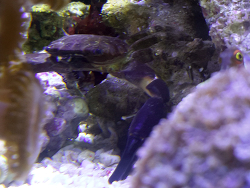Info
(Forskål, 1775)
Many species of the family Xanthidae can be poisonous, although they themselves have no poisonous apparatus (poisonous teeth, poisonous spines, poisonous glands in the skin), the consumption of these crustaceans can even be fatal for humans. Such animals are considered passive-poisonous.
The toxins of crabs (saxitoxin and tetrodotoxin) are produced by endobacteria and stored in the flesh of the crab, these e are highly potent and similar to the neurotoxins of puffer fish and just as deadly.
In its raw and cooked meat, consumption of the crab meat is toxic to humans!
Please be sure to clarify whether the meat of these crabs is toxic or non-toxic before eating it!
Call an emergency doctor immediately at the first signs of poisoning (e.g. breathing problems, muscle cramps)!
The good news is there’s no way you can be exposed to these toxins if you don’t try to eat these crabs – a bite or a jab isn’t going to do the job.
The bad news for those who unwittingly consume these crabs is that cooking the meat isn’t going to make the toxins any less effective.
Fortunately, toxic crabs don’t want to be eaten just as much as we shouldn’t be eating them, so they help us out with their glorious warning colours.
Synonyms:
Cancer clymene Herbst, 1801
Cancer nigra Forskål, 1775
Chlorodius depressus Heller, 1861
Chlorodius hirtipes White, 1848
Chlorodius nebulosus Dana, 1852
Chlorodius niger (Forskål, 1775)
am 04.06.18#18
Habe die Krabbe bereits als recht großes Tier (ca. 4 cm Carapaxbreite) über das Lebendgestein bekommen. Anfangs war sie noch recht scheu und nur in der Nähe ihrer Höhle im Originalstein zu finden, bei der kleinsten Bewegung ist sie sofort darin verschwunden. Schnecken und Einsiedler die der Höhle zu Nahe kamen wurden schwungvoll weg gekegelt.
Inzwischen ist sie gar nicht mehr scheu und wandert durch das ganze Riff. Eine feste Höhle hat sie meiner Beobachtung nach nicht mehr, allerdings gibt es in meinem kleinen 200 Liter Becken auch sehr viele Versteckmöglichkeiten. Inzwischen verhält sie sich außerdem auch sehr höflich allen anderen Bewohnern gegenüber, andere Krabben, Fische, Einsiedler, selbst die winzigen Sexy Shrimps bleiben völlig unbehelligt. Ich habe auch nie erlebt, dass sie sich an Korallen vergriffen hätte. Tagsüber knabbert sie unermüdlich, aber nicht übermäßig effektiv, am Aufwuchs und kommt bei jeder Fütterung herausgeschossen, um sich ihren Anteil zu sichern.
Mittlerweile hat sie sich schon 3 mal gehäutet und ist dabei sicher nochmal um einen Zentimter gewachsen. Trotz der relativen Größe im doch recht kleinen Becken und dem Aussehen und den Bewegungen, die irgendwie an eine Unterwasser-Vogelspinne erinnern in meinen Augen ein sehr interessantes und völlig harmloses Tier.
am 25.10.16#17
Ich habe diese Krabbe als bereits sehr großes Exemplar mit dem Lebendgestein eines anderen Aquarianers bekommen. Sie frisst bevorzugt Pelletfutter, ich habe aber auch einmal mitbekommen, wie sie meinem Clownfisch eine "gewischt" hat - der ausgewachsene Clownie schwamm dann erstmal etwas benommen neben der Krabbenhöhle, während die Krabbe am Eingang lauerte. Habe sie sofort vom Fisch vertrieben.
Außerdem ist meine Monti angefressen... vermute auch hier die Krabbe.
am 18.12.14#16
Hallo,
ich weiss nicht warum mein alter Text bei Chlorodiella sp. 01 gelandet ist, geschrieben hat ich diesen zum Bild der Chlorodiella nigra, deshalb noch mal:
Genau die auf dem Bild gezeigte Krabbe hatte ich im Aquarium, war anfangs recht klein, Panzer ~ 5mm breit, mit teils weißer Zeichnung, die aber mit zunehmender Größe verschwunden ist. Nach dem sie recht standortstreu ist und die Chlorodiellas als harmlose Algen-Aufwuchsfresser beschrieben sind, dachte ich sie kann im Aquarium bleiben… Bis zu einer Größe von nun 1,5cm Panzerbreite hat sie meine Fische auf jeden Fall in Ruhe gelassen, lies sich sogar von meinen Pseudanthias pulcherrimus vertreiben! Allerdings hatte ich die letzte Zeit zunehmend Schäden an meiner Montipora digitata beobachtet und seit zwei Tagen waren einige gewebefreie Stellen an meiner Seriatopora hystrix! Hatte die Krabbe erst gar nicht in Verdacht, obwohl sie ihre Höhle direkt daneben hatte… Vorhin konnte ich sie dann beobachten, wie sie Gewebe von meiner Digitata frisst, habe sie deshalb entfernt und würde auch jedem raten, diese Tiere genau zu beobachten und im Zweifel nicht im Becken zu lassen!
Wiederholen tu ich mich, weil ich mal wieder eine Nigra im Becken habe, die wie die Alte Korallen schädigt! Die Jetzige hat es besonders auf meine Acropora microclados und eine blau – graue Acropora sp., abgesehen. Konnte sie mehrfach beobachten wie sie Gewebe von den Korallen schabt, bei der A.sp. die Spitzen und bei der mircroclados am Fuß immer kleine Flecken kleiner 1cm, das aber teils an 2-3 Stellen direkt hintereinander! Bei größeren Korallenstöcken heilt das problemlos aus, aber wenn bei Kleinen, regelmäßig, die Spitzen abgefressen werden ist das nicht gerade förderlich!
Gruß Michael







 dasulli
dasulli














